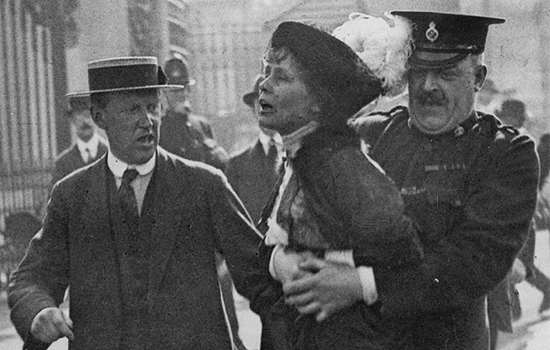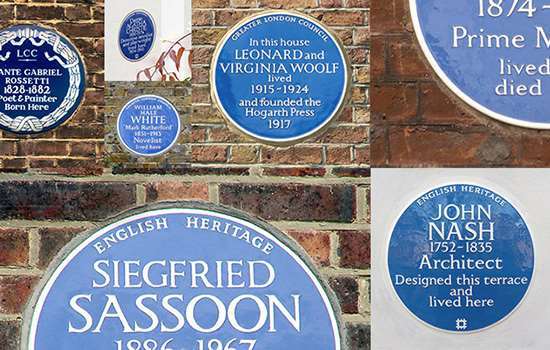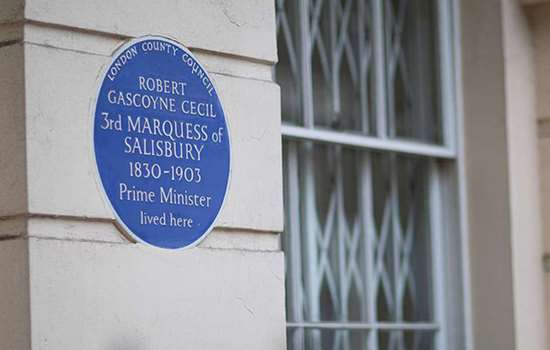LYELL, Sir Charles (1797–1875) & GLADSTONE, William Ewart (1809–1898)
Plaque erected in 1908 by London County Council at 73 Harley Street, Marylebone, London, W1G 8QJ, City of Westminster
All images © English Heritage
Profession
Politician, Geologist
Category
Politics and Administration, Science
Inscription
In a house on this site lived from 1854-1875 SIR CHARLES LYELL Geologist and from 1876-1882 W.E. GLADSTONE Statesman
Material
Encaustic
The house which formerly stood at 73 Harley Street, Marylebone, was home to Sir Charles Lyell, a key figure in the development of geology as a modern science, and later to William Ewart Gladstone, Prime Minister for four separate spells between 1868 and 1894.
Lyell: Career and Achievements
Charles Lyell was born in Scotland but grew up in Hampshire. He trained as a lawyer but from childhood his real interest was in natural history. He became a fellow, and later president, of the Geological Society, and was admitted to the Royal Society in 1826. For a few years he was Professor of Geology at King’s College, London.
At that time, the general view of geological development was ‘catastrophist’ – a belief that the form of much of the physical earth could only be explained by extraordinary events that lay beyond full human comprehension, such as the flood described in the Bible. Lyell argued instead that any geological phenomena could, over time, be produced by processes that could still be observed – some very gradual and some, like an earthquake or the eruption of a volcano, spectacular and sudden.
This line of thought, which inferred that the earth was older than had widely been assumed previously, became known as ‘uniformitarianism’. While not new, it was fully explored in Lyell’s key work, the three-volume The Principles of Geology (1830–33).
The book was influential: Charles Darwin took The Principles of Geology with him on HMS Beagle. Lyell travelled widely to pursue his studies, accompanied by his wife Mary who was an expert in fossil shells and able to help him to overcome the problem of poor eyesight. His book Travels in North America (1845) emerged from one such trip. In it, he showed himself more concerned at the possibility of slave insurrection than he was at the conditions under which the slaves toiled – an attitude that disturbed Darwin.
Lyell was among those who urged Darwin to publish his theory of evolution, though he never entirely accepted that it could explain mankind’s higher functions.
His other chief legacy to science was the division of the tertiary period of geological time into the Eocene, Miocene and Pliocene periods – terms still in use.
Lyell in London
The Lyells’ first married home was in Hart Street, Bloomsbury (now entirely rebuilt as Bloomsbury Way). They moved to number 11 Harley Street (later renumbered 24 but demolished), and then, in the autumn of 1854, to 53 Harley Street. Renumbered 73 in 1866, this house has also been rebuilt, with the present structure dating from 1905.
While living here, Lyell wrote The Antiquity of Man (1863) and prepared new editions of The Principles of Geology, which reached its eighth edition in 1873, and Elements of Geology, first published in 1838. He was made a baronet in 1864, having been knighted 16 years earlier.
Despite his growing physical frailty, Lyell continued to make geological tours at home and abroad. After Mary died in 1873 he took refuge in his studies, writing: ‘I endeavour by daily work at my favourite science to forget as far as possible the dreadful change which this has made in my existence.’ Two years later, he died in his bedroom in Harley Street.
Gladstone: A Political Comeback
Lyell was succeeded at the house that stood on this site by William Ewart Gladstone who, having resigned as Prime Minister and leader of the Liberal Party in 1874, made this his London base from May 1876. He is also commemorated at a previous address in Carlton House Terrace and a subsequent one in St James’s Square.
During his four years at this address, Gladstone at first distanced himself from politics, taking refuge in literary pursuits in his sparsely furnished study, with its fireplace tiled with Homeric subjects.
However, the issue of the ‘Bulgarian atrocities’ – a series of attacks by agents of the Ottoman (Turkish) empire against Christians in the Balkans – saw him renew his attacks on Benjamin Disraeli, Lord Beaconsfield, who was his successor as Prime Minister. Gladstone disagreed with Disraeli’s foreign policy, which stressed immediate British interests rather than issues of wider morality.
During the Midlothian campaign (1879–80) – Gladstone’s successful bid to win a parliamentary seat in Scotland – he launched a wider assault against colonial wars, defending the rights of Afghans and Zulus to defend themselves: ‘If they resisted, would you not have done the same?’ he asked one election crowd.
He went on to list six principles for British foreign policy, including promotion of peace and keeping ‘the powers of Europe in union together’. Gladstone did not always find this easy to live up to during his second term as Prime Minister (1880–85): episodes like the bombardment of Alexandria and the invasion of Egypt sat awkwardly with his earlier statements.
The plaque states that Gladstone lived here until 1882. In fact, though he retained the lease until then, he moved to 10 Downing Street in May 1880.
Nearby Blue Plaques
More About Blue Plaques



